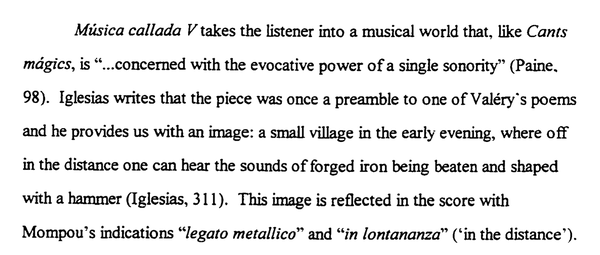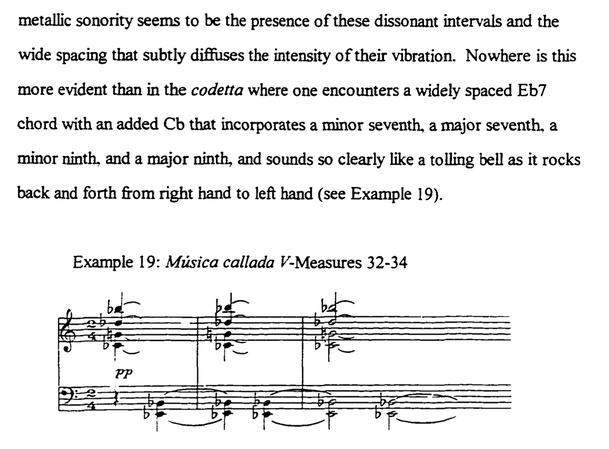Increasingly, I'm hearing the bells in the music.The bells are there from the outset. The first piece, 'Angelico', begins with a symmetrical 'tone formation' - A & B, D& E - two major seconds separated by a minor third - and it is out of this that a melody emerges. The 3 notes below the melody chime like a bell, hanging in space, as the melody floats above. Then follow three quite different pieces; as Eric Daub mentions in his excellent analysis of Musica Callada, "While the presence of contrasts within the individual pieces is usually rather subtle, the contrasts encountered between the pieces can be quite pronounced". When we reach #5 we are "taken into a musical world that is concerned with the evocative power of a single sonority". I was listening to this piece while driving the other day, and the performance (by James Rushford) struck me (pun intended?) in a way it never had before. These are clearly bells; I'd never heard the chords in this particular piece as bells before, after 30 years of knowing this music - and the harmonies Mompou has written must have been derived from a study of the actual overtones of bells. The dissonances arise from major sevenths and minor ninths... The bells continue to underpin the music as we go further into Book 1, and then into Book 2. Nos. 11 and 12 are both very bell-like, to my ears: 11 has a bright carillon-like theme at the opening and closing, like an announcement; no 12 has "colourfully dissonant metallic sonorities" [Eric Baum] which move into passages using the octatonic scale. The use of this scale to produce magical and mystical effects has precedents in 20th C music, most notably in the music of Scriabin, and Stravinsky. In his blog "The Departing Landscape', Steven D Foster describes 'Musica Callada' as a sacred music: "I consider Musica Callada to be a sacred work of art, and there are several ways in which I have become certain of this fact. First of all, when I listen to Mompou's music I become entranced by its sweet melodies, its constant other-worldly ringing of bells, its palpable and sensitive use of silent spaces, and its elegant dissonances which are pervaded with transcendent charm. All this is to say that the music absorbs my attention, opens my heart and transports me to beautiful unknown worlds. " He goes on - "The third chapter of Wilfred Mellers' book Le Jardin Retrouve, The Music of Frederic Mompou is devoted to bells. He begins the chapter with some interesting history: "The musical synonym for 'pre-consciousness" is the bell. Both real bells (inverted cups, usually of metal, hit with an attached clapper or externally activated hammer) and crotals (hollowed gourd-like objects with a free body, such as pea or pebble, inserted) may be said to belong to God in that they reveal the acoustical properties of Nature. Some 26,000 years before Christ the Chinese Emperor Chuan Hao 'struck the bell and called the attention of the people, so that he could teach them righteousness'; the teaching came after the submission to Nature. Chinese bells were decorated with dragons and other fabulous creatures least demons should threaten the transcendental power whereby bells sustained the Universal Harmony; without truly resonating bells the universe might collapse. Most ancient oriental cultures regarded bells as agents and activators of magic. Hindus found in them the circle, hemisphere and lotus basic to their cosmology . . . "Vladimir Jankelevitch writes about the resounding bells in Mompou's Musica Callada in an essay "Mompou's Message" which can be found--in English translation!--in the booklet that comes with the 4CD set entitled Mompou : Complete Piano Works on the Brilliant Classics label. It is an important essay; here are some excerpts taken from it: "Mompou's piano pieces constantly allude to bronze . . . the bronze of bells vibrates and resounds in the musical space where Mompou's compositions are heard . . . especially in Musica Callada (Silent Music): here one hears seraphic bells which chime softly between heaven and earth. "It is hard to decide what to admire most in these wonderful piano pieces where the pressure of each finger has been subtly considered. "Profundo" (deeply): this indication for performance enamels all Mompou's works, as if wanting to penetrate in the deepest part of the soul; the sonorities are sedative, calming, serious, vehement, or sometimes mysteriously hammered out, and often, they are soft and captivating. The sweet melodies create a sonorous light in the depth. Between the airy notes and the deep ones, an intermediate voice stands out, which sketches the internal song of harmony . . . "In the whole work the musician lets another voice, originating in the "resonating" strings, sing . . . and this second voice, this secret voice, this "internal voice" addresses us as if it were the voice of the soul. This unspoken music gives the music we hear its vibrant fullness. From all this comes a sonority which is at the same time hidden and delicately articulated, a fleeting sonority, and yet, luminous, evasive but unattached . . . [for] distance and space underlie all the impressions and images in Mompou . . . "It seems right to me that, over the years, the mystic silence represented more and more for Federico Mompou the intimacy of the internal state towards which he always moved. The serenity he always searched for is even more static than withdrawn. The existence of his aestheticism was confirmed . . . above all in the four books of Musica Callada. . . . What Mompou wants is the search for "sonorous solitude"; to reach the intangible point where music becomes the very voice of silence, where silence itself becomes music. . . . Mompou aspired to let the voice of the pure soul sing, the soul alone, the soul itself in itself . . . Vladimir Jankelevitch, "Mompou's Message" published in the Brilliant Classics booklet. (my underlines)"
0 Comments
Leave a Reply. |
Details
Archives
September 2022
Categories |







 RSS Feed
RSS Feed
